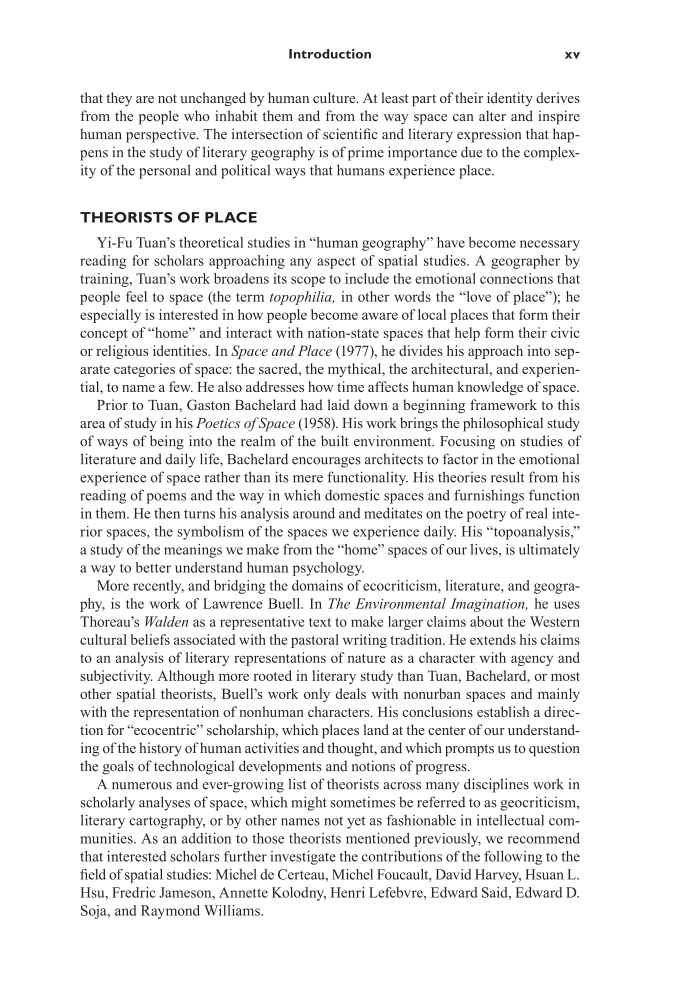Introduction xv that they are not unchanged by human culture. At least part of their identity derives from the people who inhabit them and from the way space can alter and inspire human perspective. The intersection of scientific and literary expression that hap- pens in the study of literary geography is of prime importance due to the complex- ity of the personal and political ways that humans experience place. THEORISTS OF PLACE Yi-Fu Tuan’s theoretical studies in “human geography” have become necessary reading for scholars approaching any aspect of spatial studies. A geographer by training, Tuan’s work broadens its scope to include the emotional connections that people feel to space (the term topophilia, in other words the “love of place”) he especially is interested in how people become aware of local places that form their concept of “home” and interact with nation-state spaces that help form their civic or religious identities. In Space and Place (1977), he divides his approach into sep- arate categories of space: the sacred, the mythical, the architectural, and experien- tial, to name a few. He also addresses how time affects human knowledge of space. Prior to Tuan, Gaston Bachelard had laid down a beginning framework to this area of study in his Poetics of Space (1958). His work brings the philosophical study of ways of being into the realm of the built environment. Focusing on studies of literature and daily life, Bachelard encourages architects to factor in the emotional experience of space rather than its mere functionality. His theories result from his reading of poems and the way in which domestic spaces and furnishings function in them. He then turns his analysis around and meditates on the poetry of real inte- rior spaces, the symbolism of the spaces we experience daily. His “topoanalysis,” a study of the meanings we make from the “home” spaces of our lives, is ultimately a way to better understand human psychology. More recently, and bridging the domains of ecocriticism, lit er a ture, and geogra- phy, is the work of Lawrence Buell. In The Environmental Imagination, he uses Thoreau’s Walden as a representative text to make larger claims about the Western cultural beliefs associated with the pastoral writing tradition. He extends his claims to an analysis of literary represen ta tions of nature as a character with agency and subjectivity. Although more rooted in literary study than Tuan, Bachelard, or most other spatial theorists, Buell’s work only deals with nonurban spaces and mainly with the represen ta tion of nonhuman characters. His conclusions establish a direc- tion for “ecocentric” scholarship, which places land at the center of our understand- ing of the history of human activities and thought, and which prompts us to question the goals of technological developments and notions of progress. A numerous and ever- growing list of theorists across many disciplines work in scholarly analyses of space, which might sometimes be referred to as geocriticism, literary cartography, or by other names not yet as fashionable in intellectual com- munities. As an addition to those theorists mentioned previously, we recommend that interested scholars further investigate the contributions of the following to the field of spatial studies: Michel de Certeau, Michel Foucault, David Harvey, Hsuan L. Hsu, Fredric Jameson, Annette Kolodny, Henri Lefebvre, Edward Said, Edward D. Soja, and Raymond Williams.
Document Details My Account Print multiple pages
Print
You have printed 0 times in the last 24 hours.
Your print count will reset on at .
You may print 0 more time(s) before then.
You may print a maximum of 0 pages at a time.

























































































































































































































































































































































































































